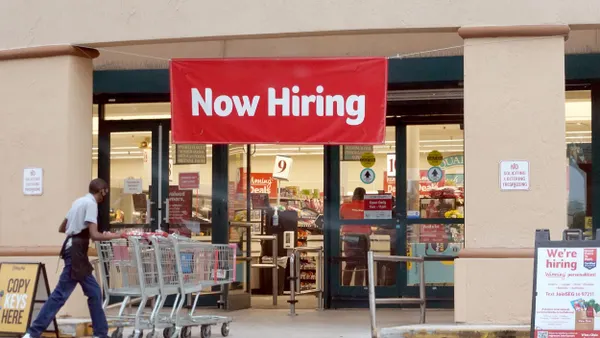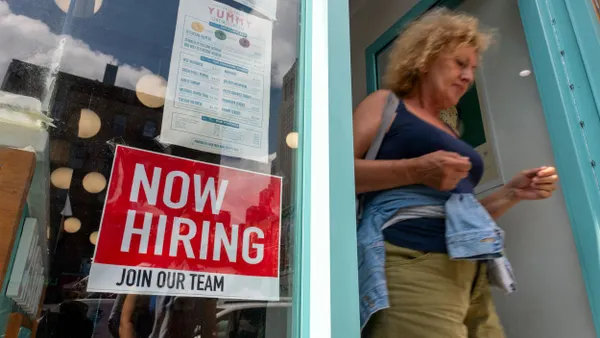Breaking down the monthly BLS job report
Below are the most recent U.S. Bureau of Labor Statistics (BLS) reports on “The Employment Situation” — the bureau’s term for the monthly jobs report.
Each report provides data on the month prior (September’s report covers August numbers, for example), and numbers are regularly adjusted in future reports.


-
August 2024
4.2% unemployment rate142,000 jobs added
Total nonfarm payroll increased by 142,000 in August and the unemployment rate dropped slightly to 4.2%, according to the U.S. Bureau of Labor Statistics, signaling a continued flattening of the job market.
BLS also reported net negative revisions for June and July payroll employment numbers, coming in at 86,000 lower than previously stated.
“For the third month in a row, the labor market has underwhelmed expectations as businesses have rapidly scaled back their willingness to hire,” Sam Kuhn, Appcast’s labor economist, said in a statement. “While hiring activity has cooled, we’ve yet to see wide-scale layoffs as the unemployment rate did not change this month after steadily rising the past year.”
The U.S. Federal Reserve’s latest Beige Book also reported this week that employment levels were largely flat or only up slightly in recent weeks, indicating that employers “were more selective with their hires and less likely to expand their workforces, citing concerns about demand and an uncertain economic outlook.”
However, the report also showed that employers remained reluctant to let workers go, indicating retention may be the name of the game.
“Today’s jobs report demonstrates that this summer’s Great Waiting Game has continued, with both employers and employees holding out for proof of improvement versus speculation of forecasts,” Becky Frankiewicz, president of ManpowerGroup North America, said in a statement. “Our real-time data showed an August pick-up in job postings following a slower July, but year-over-year stability. We’re not seeing that translate into the BLS just yet.”
Released Sept. 6, 2024
-
July 2024
4.3% unemployment rate114,000 jobs added
Nonfarm payroll employment rose by 114,000 jobs in July, according to the U.S. Bureau of Labor Statistics, but unemployment jumped to 4.3% — a report that economists greeted with some alarm.
Glassdoor Lead Economist Daniel Zhao said the report showed “a job market at an inflection point,” while Nick Bunker, economic research director for North America for Indeed Hiring Lab, said the labor market “is in a perilous spot.”
Due to revisions, the three-month average for job growth is below 170,000, “the lowest in the post-pandemic recovery,” said Sam Kuhn, economist for Appcast. Of the jobs added in July, only 33,000 were in the private sector outside of healthcare and social assistance, Julia Pollak, ZipRecruiter’s chief economist said. Wage growth has also slowed.
“Something needs to change for the labor market to remain relatively healthy,” Bunker said. “It’s not clear if that change can come in time.”
Released Aug. 2, 2024
-
June 2024
4.1% unemployment rate206,000 jobs added
Total nonfarm payroll rose by 206,000 in June, according to the U.S. Bureau of Labor Statistics, but the unemployment rate rose to 4.1% — the first time it has hit over 4% since November 2021.
Economists pointed to several signs of slowdown in the market, including downward revisions for previous months’ job additions, slowed wage growth and rising numbers of unemployed workers.
“Over the past several months, the rate at which employed workers have moved into unemployment has steadily increased, a sign that job loss might be on the rise,” Nick Bunker, economic research director for North America for Indeed Hiring Lab, said in a statement. “This trend deserves careful consideration."
Other data also points to continued slowdown. According to ZipRecruiter data sent to HR Dive, job postings on the site have fallen for the past four weeks, and leisure and hospitality job openings — which have driven many gains in recent data — have started to drop, according to Julia Pollak, ZipRecruiter’s chief economist.
Released July 5, 2024
-
May 2024
4.0% unemployment rate272,000 jobs added
Total nonfarm payroll increased by 272,000 in May and the unemployment rate rose to 4%, indicating a potential “soft landing” despite concerns about the job market’s continued strength, economists said.
The rise in the unemployment rate may be attributed to “a more challenging hiring season” for teens and new grads, Julia Pollak, ZipRecruiter’s chief economist, said in a statement. The unemployment rate for workers aged 16-24 rose a full percentage point, Nick Bunker, economic research director for North America at Indeed Hiring Lab, said.
The Fed may have been looking for a softer report, Pollak said, especially amid a slew of mixed reports across other economic factors. For example, ZipRecruiter data said online job postings ticked up in May, while ManpowerGroup data sent to HR Dive indicated an 8% month-to-month drop in job postings.
“The labor market has defied expectations for so long that it might seem invincible. But nothing ever is,” Bunker said in a statement. “The current trajectory is positive, but with declining demand for workers, it can’t hold up forever.”
Released June 7, 2024
-
April 2024
3.9% unemployment rate175,000 jobs gained
Total nonfarm payroll employment increased by 175,000 in April, according to the U.S. Bureau of Labor Statistics, coming in under economist expectations. The unemployment rate also ticked up to 3.9%.
The slowdown was greeted with something of relief from economists, noting that the slower gains were signs of moderation that the Federal Reserve has been looking for in its fight against inflation. “The labor market remains quite resilient,” Sam Kuhn, Appcast economist, said in a statement. “The gap between supply and demand continues to narrow.”
Industries that had seen catch-up gains in jobs in the wake of the pandemic, such as government jobs and leisure and hospitality, cooled significantly though maintained growth. Wage growth also cooled, rising at its slowest pace since June 2021, Nick Bunker, economic research director for North America for Indeed Hiring Lab, said in a statement.
“On its own, this report, while not great, is not necessarily overly worrisome — when the market is cooling as it is, you should expect a few reports like this from time to time,” Bunker said.
Released May 3, 2024
-
March 2024
3.8% unemployment rate303,000 jobs added
Total nonfarm payroll employment rose 303,000 in March and unemployment dipped slightly to 3.8%, according to the U.S. Bureau of Labor Statistics, beating economist expectations and confirming an economy that is still largely stable amid attempts to slow inflation.
Employment for January was revised upward slightly, as well; despite a minor revision downward for February, jobs were 22,000 higher than previously reported over the two months.
“While employer demand remains high, worker supply is rising to meet it, reversing some of the softening observed in the past few months. Clearly, the job market has plenty of gas in the tank in terms of demand, and also has room to run in terms of worker supply,” Nick Bunker, economic research director for North America for Indeed Hiring Lab, said in a statement.
The report is also consistent with other rising indicators; Julia Pollak, ZipRecruiter’s chief economist, noted that online job postings (recorded from ZipRecruiter data) have risen for two straight months after a 20-month slide, and this report confirms that strength.
Released April 5, 2024
-
February 2024
3.9% unemployment rate275,000 jobs added
Total nonfarm payroll rose by 275,000 in February while the unemployment rate rose to 3.9%, according to the U.S. Bureau of Labor Statistics. The numbers showcase a labor market that is continuing to gradually cool, economists said.
While wage growth was strong — good news for workers, who have seen a long slew of real wage declines thanks to inflation, economists said — employment numbers from January and December were revised down by a total of 167,000 jobs, indicating the economy was not as hot as previously recorded.
“The report is consistent with data from the JOLTS report earlier this week showing that rates of hiring and quits are below pre-pandemic rates, and with anecdotal evidence from the Fed’s March 6 Beige Book pointing to a slacker labor market with improved labor availability and retention,” Julia Pollak, ZipRecruiter’s chief economist, said in a statement.
The tech sector, which has been especially clobbered by layoffs, also saw flat numbers in February, meaning the “techcession” may not be over, Pollak said.
Released March 8, 2024











